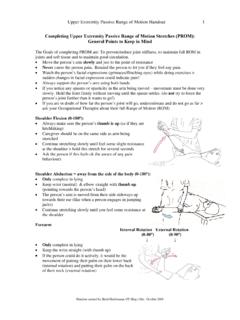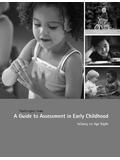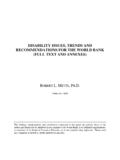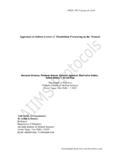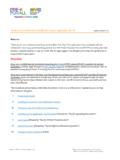Transcription of Assessments that can be used by School Occupational …
1 Assessments that can be used by School Occupational Therapists Compiled by Tracy Benemerito-Stead Created February 2005 (Please note that more than one company may sell the assessment . Also, this is just a sample of tests used by Occupational Therapists in School Systems. This is just a general overview.) Company that sells the following tests: Pro-Ed School Functional assessment (SFA) - The School Function assessment measures a student's performance of functional tasks that support participation in the academic and social aspects of an elementary School program (grades K-6). It was designed to facilitate collaborative program planning for students with a variety of physical and cognitive disabilities.
2 Developmental Test of Visual Perception Adolescent and Adult (DTVP-A) - The DTVP-A is a battery of six subtests that measure different but interrelated visual-perceptual and visual-motor abilities. The battery, which is designed for use with individuals ages 11-0 through 74-11, has empirically established reliability and validity. The subtests and indexes also will suggest areas of emphasis in cognitive and fine motor rehabilitation. The DTVP-A is particularly useful in distinguishing true visual-perceptual deficits from problems solely with complex eye-hand or perceptual-motor actions. Developmental Test of Visual Perception 2 -The DTVP2 is suitable for children ages 4 to 10, measures both visual perception and visual motor integration skills, has eight subtests, is based on updated theories of visual perceptual development, and can be administered to individuals in 35 minutes.
3 The DTVP2 subtests are Eye-Hand Coordination, Copying, Spatial Relations, Position in Space, Figure-Ground, Visual Closure, Visual-Motor Speed, and Form Constancy. Beery VMI, 5th Edition - The Beery VMI helps assess the extent to which individuals can integrate their visual and motor abilities. The Short Format and Full Format tests present drawings of geometric forms arranged in order of increasing difficulty that the individual is asked to copy. Clinical Observation of Motor and Postural Skills (COMPS-2) - The Clinical Observations of Motor and Postural Skills, Second Edition (COMPS-2) is a reliable, standardized screening tool that identifies children with motor coordination problems who may benefit from sensorimotor or sensory integration therapy.
4 Motor control characteristics assessed relate to cerebellar function, postural control, and motor control. The six CO items included are: slow movements, rapid forearm rotation, finger-nose touching, prone extension posture, asymmetric tonic neck reflex (ATNR), and supine flexion posture. This test is designed to assess children with subtle motor coordination problems, also called developmental coordination disorder (DCD). It is not recommended for use with children diagnosed with neurological problems, such as cerebral palsy. Motor-Free Visual Perception Test (MVPT-3) - Designed to assess visual perception without reliance on an individual's motor skills, the MVPT-3 is particularly useful with those who may have learning, cognitive, motor, or physical disabilities.
5 The MVPT-3 measures skills without copying tasks. It contains many new, more difficult items at the upper end for older children and adults. Tasks include matching, figure-ground, closure, visual memory, and form discrimination. Test of Visual Motor Integration (TVMI) - The TVMI measures visual motor ability in students ages 4 to 17 by asking them to copy a series of increasingly complex geometric figures. Test of Handwriting Skills (THS) - The THS measures neurosensory integration ability in either manuscript or cursive, in both uppercase and lowercase forms from the following: writing letters of the alphabet in alpha sequence (uppercases and lowercases) from memory; writing letters of the alphabet out of alpha order (uppercases and lowercases) from dictation; writing eight numbers out of numerical order from dictation; copying 12 uppercase selected letters of the alphabet out of alpha sequence; copying 10 lowercase selected letters of the alphabet out of alpha sequence; copying six words (21 letters); copying two sentences (6 words, 29 letters).
6 And writing six words (21 letters) from dictation. Peabody Developmental Motor Scales (PDMS-2) - The PDMS2 is an early childhood motor development program that provides (in one package) both in-depth assessment and training or remediation of gross and fine motor skills. The assessment is composed of six subtests that measure interrelated motor abilities that develop early in life. It is designed to assess the motor skills of children from birth through 5 years of age. Bruininks-Oseretsky Test of Motor Proficiency (BOTMP) - The Bruininks-Oseretsky Test of Motor Proficiency (BOTMP) thoroughly assesses the motor proficiency of able-bodied students, as well as students with serious motor dysfunctions and developmental handicaps.
7 It provides a comprehensive picture of a child's motor development. The test can also be useful in developing and evaluating motor training programs. Spatial Awareness Skills Program - The Spatial Awareness Skills Program (SASP) assesses and teaches the fundamental analysis and organization abilities that enable children to make sense out of arithmetic and, more generally, to address written work and multi-step listening and reading comprehension tasks in an efficient, step-by-step fashion. SASP focuses on analysis and organization skills. SASP is intended for use by Occupational therapists, developmental optometrists, and teachers who work with pre-kindergarten through elementary- School -age LD, ADD, or dyslexic children, individually or in groups.
8 Functional Evaluation for Assistive Technology (FEAT) - The Functional Evaluation for Assistive Technology (FEAT) is an easy-to- use, systematic, comprehensive, multidimensional, and ecologically-based assessment protocol that can be used with people of all ages ( , elementary aged students through postsecondary adults). The scale can be used to determine the most appropriate and effective assistive technology devices to help individuals with learning problems ( , learning disabilities, mental retardation) compensate for their difficulties and meet the demands of specific tasks and contexts. Company that sells the following tests: Psychological Corporation: MHA (Minnesota Handwriting assessment ) - Use the Minnesota Handwriting assessment with first and second grade students to analyze handwriting skills, including standard manuscript and D'Nealian styles of print.
9 This test has normative information, substantiating its test/retest reliability. Use the test to identify how students are performing in relationship to their peers. It also demonstrates progress as a result of intervention. Scores are based on rate and five quality categories-Legibility, Form, Alignment, Size, and Spacing. Sensory Profile Use the Sensory Profile to determine how well children process information in everyday situations and to profile the sensory system s effect on functional performance. Adolescent / Adult Sensory Profiles Adolescent/Adult version of the Sensory Profile (WRAVMA) Wide Range assessment of Visual Motor Abilities - Visual-motor integration is assessed by measuring its component parts, Visual-Motor, Visual-Spatial, and Fine-Motor Abilities.
10 Visual-Motor integration is evaluated by copying designs. Visual-Spatial skills are assessed by the Matching Test. Fine-Motor skills are evaluated by the Pegboard Test. MAP (Miller assessment for Preschoolers) Movement ABC (Movement assessment Battery for Children) PEDI (Pediatric Evaluation of Disability Inventory) - Assess key functional capabilities and performance in children ages six months to seven years with this practical resource. Use it to evaluate older children whose functional abilities are lower than those of seven-year-olds without disabilities. Pediatric Evaluation of Disability Inventory (PEDI) lets you measure both capability and performance by observing Self-care, Mobility, Social function DeGangi-Berk Test of Sensory Integration (TSI) - permits early detection of even subtle developmental deficits that could lead to learning difficulties if ignored in children from 3 to 5 years.
